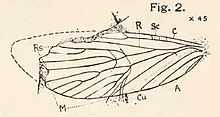Mesochorista proavita
| Mesochorista proavita Temporal range: Carnian | |
|---|---|
 | |
| Scientific classification | |
| Kingdom: | Animalia |
| Phylum: | Arthropoda |
| Class: | Insecta |
| Order: | Mecoptera |
| Family: | †Permochoristidae |
| Genus: | †Mesochorista |
| Species: | † M. proavita |
| Binomial name | |
| Mesochorista proavita Tillyard 1916 | |
| Synonyms | |
|
†Eoses triassica | |
Mesochorista proavita is an extinct species of scorpionfly from the Triassic period of Queensland, Australia.[1]
Discovery
Specimens of Mesochorista proavita were first described by the English-Australian entomologist Robert John Tillyard in 1916. The fossils were recovered from the Denmark Hill Insect Bed of Queensland, Australia. The type locality belongs to the Blackstone Formation (Ipswich Coal Measures Group) and is dated to the Carnian age (228.0 - 216.5 million years ago) of the Triassic period.[2]
Specimens of Eoses triassica, sometimes considered a synonym of this species, were discovered in 1945 by the Australian entomologist Norman Tindale from the Mt. Crosby Insect Bed of Queensland, Australia. They are also dated to the Carnian age.[2]
Taxonomy
M. proavita belongs to the family Permochoristidae (formerly Mesochoristidae) of the scorpionflies (order Mecoptera).[2][3]
E.F. Riek synonymized Eoses triassica with M. proavita in 1955, regarding it as a second specimen. In doing so, he identified the fossil as a mecopteran rather than a lepidopteran as it was originally described as.[4][5] Citing morphological differences in wing venation and publishing errors, Norman B. Tindale challenged this conclusion in 1980. He maintains that the three known specimens of Eoses triassica belong to the lepidopteran family Eocoronidae.[6]
See also
- Prehistoric insects
- Prehistoric Lepidoptera
References
- ↑ E.F. Riek (1955). "A Re-examination of the Mecopteroid and Orthopteroid Fossils (Insecta) from the Triassic Beds at Denmark Hill, Queensland, with Descriptions of Further Specimens" (PDF). Australian Journal of Zoology 4: 98–110. doi:10.1071/zo9560098. Retrieved 11 August 2011.
- ↑ 2.0 2.1 2.2 "Mesochorista proavita". Paleobiology Database. Retrieved 11 August 2011.
- ↑ E.F. Riek (1953). "Fossil mecopteroid insects from the Upper Permian of New South Wales" (PDF). Records of the Australian Museum (Australian Museum) 23 (2): 55–87, plates v–vi. doi:10.3853/j.0067-1975.23.1953.621. ISSN 0067-1975. Retrieved 11 August 2011.
- ↑ R.A. Crowson, W.D.I. Rolfe, J. Smart, C.D. Waterston, E.C. Wiley, & R.J. Wootton (1967). "Chapter 19: Arthropoda: Chelicerata, Pycnogonida, Palaeoisopus, Myriapoda and Insecta" (PDF). The Fossil Record (Geological Society of London): 499–534. Retrieved 11 August 2011.
- ↑ E.F. Riek (1955). "A Re-examination of the Mecopteroid and Orthopteroid Fossils (Insecta) from the Triassic Beds at Denmark Hill, Queensland, with Descriptions of Further Specimens" (PDF). Australian Journal of Zoology 4: 98–110. doi:10.1071/zo9560098. Retrieved 11 August 2011.
- ↑ Norman B. Tindale (1980). "Origin of the Lepidoptera, With Description of a New Mid-Triassic Species and Notes on the origin of the Butterfly Stem" (PDF). Journal of the Lepidopterists' Society 34 (3): 263–285. Retrieved 11 August 2011.